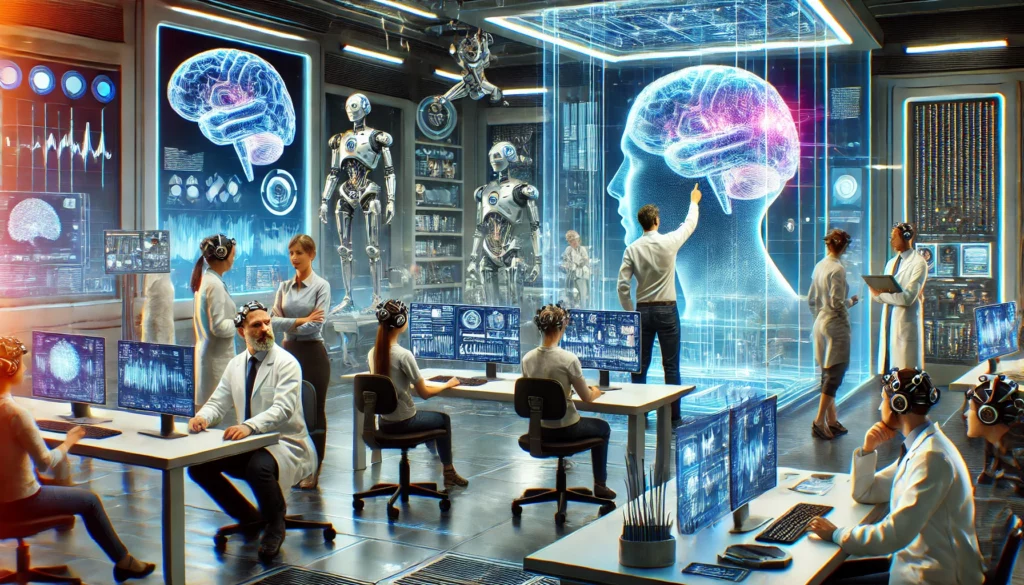Introducing the Brain-Computer Interface
The concept of the brain-computer interface (BCI) has long fascinated scientists, futurists, and the public alike. Imagine a world where thoughts could control technology, where the divide between human cognition and machine capabilities blur seamlessly. This idea, once the domain of science fiction, is rapidly moving towards reality thanks to advances in neuroscience, computer science, and bioengineering. BCIs hold the potential to revolutionize fields as diverse as medicine, communication, and entertainment. As we look to the future, it’s essential to understand the current state of BCI technology, its potential applications, and the ethical considerations that accompany this transformative development.

The Current State of Brain-Computer Interface Technology
Understanding Brain-Computer Interfaces
At its core, a BCI is a system that enables direct communication between the brain and an external device. This is typically achieved by recording brain signals, interpreting them, and then translating them into commands that can control a computer or other digital devices. The primary methods of recording these signals include electroencephalography (EEG), electrocorticography (ECoG), and invasive techniques such as microelectrode arrays implanted directly into the brain tissue.
Recent Advancements in the Brain-Computer Interface
In recent years, there have been significant advancements in both the hardware and software that underpin BCI technology. Improved signal processing algorithms, machine learning, and artificial intelligence have enhanced the accuracy and reliability of interpreting brain signals. Meanwhile, advancements in neural imaging and minimally invasive techniques are making BCIs safer and more accessible.
One notable development is the emergence of non-invasive BCIs that utilize EEG. These systems have become more user-friendly and less obtrusive, enabling broader adoption. Additionally, companies like Neuralink, founded by Elon Musk, are pushing the boundaries with high-bandwidth, invasive BCIs that aim to achieve seamless integration with the brain.
Potential Applications of the Brain-Computer Interface
Medical Rehabilitation and Assistive Technologies
One of the most promising applications of BCIs is in medical rehabilitation and assistive technologies. BCIs can help restore communication and mobility to individuals with severe disabilities. For example, people with amyotrophic lateral sclerosis (ALS) or locked-in syndrome can use BCIs to communicate by controlling a computer cursor or speech-generating device with their thoughts. Similarly, BCIs can assist in controlling prosthetic limbs, allowing amputees to regain a sense of autonomy and functionality.
Enhancing Cognitive Abilities
BCIs hold the potential to enhance cognitive abilities, offering applications in both educational and professional settings. By interfacing directly with the brain, BCIs could enable more efficient learning processes, memory enhancement, and even cognitive augmentation. Imagine students being able to download information directly to their brains or professionals using BCIs to improve focus and productivity.
Communication and Entertainment
The entertainment industry could be revolutionized by BCIs, creating immersive experiences that respond to a user’s mental state. BCIs could enable new forms of gaming where players control the game environment with their thoughts or even experience virtual reality in a more profound way. In terms of communication, BCIs could provide new ways for people to interact, potentially allowing for thought-based communication, bypassing traditional language barriers.
Neuroscientific Research
BCIs also offer unprecedented opportunities for neuroscientific research. By providing a direct window into brain activity, researchers can gain deeper insights into how the brain functions, leading to breakthroughs in understanding and treating neurological disorders. This research could lead to novel treatments for conditions like epilepsy, Parkinson’s disease, and depression.
Challenges and Ethical Considerations of the Brain-Computer Interface
Technical Challenges
Despite the remarkable progress, several technical challenges remain. One of the primary issues is the need for more precise and reliable signal acquisition. Non-invasive methods like EEG often suffer from poor spatial resolution and noise interference, while invasive methods carry risks associated with surgery and long-term implantation. Additionally, interpreting the complex language of the brain accurately and consistently remains a significant hurdle.
Ethical and Privacy Concerns of the Brain-Computer Interface
The development and deployment of BCIs also raise profound ethical and privacy concerns. The ability to access and potentially manipulate thoughts introduces new dimensions to privacy. Who controls the data generated by BCIs? How do we ensure that such technology is not misused for surveillance or coercion? These questions necessitate the establishment of robust ethical frameworks and regulatory measures.
Equity and Accessibility
Ensuring equitable access to BCI technology is another critical concern. There is a risk that BCIs could exacerbate existing inequalities if they are only accessible to the wealthy. It’s essential to develop strategies that ensure this transformative technology benefits all of humanity, not just a privileged few.
The Path Forward of the Brain-Computer Interface
Multidisciplinary Collaboration
The future of BCIs will depend on multidisciplinary collaboration. Neuroscientists, engineers, ethicists, and policymakers must work together to address the technical, ethical, and societal challenges. Collaborative efforts can foster innovation while ensuring that BCIs are developed and implemented responsibly.
Regulation and Standardization
As BCIs move closer to mainstream adoption, regulatory bodies must establish clear guidelines and standards. This includes ensuring the safety and efficacy of BCI devices, protecting user privacy, and addressing ethical concerns. International cooperation will be crucial in creating a cohesive regulatory framework that can keep pace with rapid technological advancements.
Public Engagement and Education
Public engagement and education are vital to the responsible development of BCIs. Informing the public about the benefits and risks of BCI technology can foster informed consent and acceptance. Additionally, involving diverse perspectives in the discussion can help ensure that the technology is developed in a way that reflects the values and needs of society.
Investment in Research and Development
Continued investment in research and development is essential for advancing BCI technology. Governments, private companies, and academic institutions must prioritize funding for BCI research to drive innovation and address the remaining technical challenges. This investment should also include support for ethical and social impact research to guide responsible development.

Conclusion
The future of brain-computer interfaces is both exciting and complex. BCIs have the potential to transform numerous aspects of our lives, from medical rehabilitation to communication and entertainment. However, realizing this potential requires addressing significant technical challenges and ethical considerations. By fostering multidisciplinary collaboration, establishing robust regulatory frameworks, engaging the public, and investing in research, we can navigate the path forward responsibly.
As we stand on the brink of this technological revolution, it’s crucial to remember that the ultimate goal of BCI technology should be to enhance human well-being and empower individuals. The future of BCIs holds immense promise, and with thoughtful development, it can usher in a new era where the boundaries between human and machine are harmoniously integrated, leading to unprecedented advancements in human capability and understanding.
